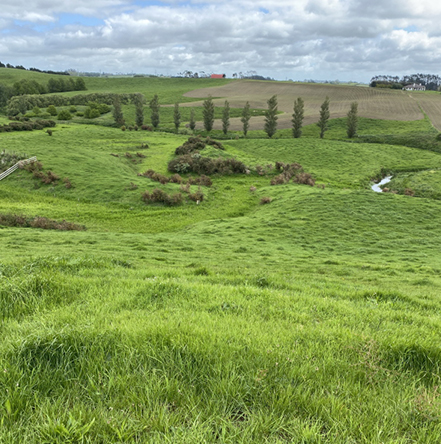Building for people and nature: Lifecare’s Paerata Road lifestyle village
At a glance...
Lifecare wanted to develop a retirement lifestyle village just outside Auckland.
They were eager not just to gain consent to develop the land, but to restore its ecology too.
We delivered an AEE and restoration plan as well as assisting with engagement with iwi.
Overview
Lifecare came to Ecological Solutions because they want to develop a retirement lifestyle property in Pukekohe, Auckland. They wanted not only to build on the land, but restore and protect its flora and fauna, creating a beautiful natural space for future residents.
The ask
“When Lifecare came to us, they said ‘we really want to do something cool here for the environment.’ And that’s exciting for us as ecologists.”
Nick Carter | Senior Freshwater Scientist, Ecological Solutions
As ecologists, we love it when clients ask for help with restoring their land as well as developing it. Lifecare came to us with two requests:
1. To carry out the ecological assessment required to apply for resource consent, and,
2. To develop a restoration plan for rehabilitating the land they want to use.
We first needed to establish whether the development is likely to be approved, and then proceed with the ecological surveys and plans.
Why us?
Our team at Ecological Solutions have worked on numerous development and restoration projects throughout the country.
Both development and restoration projects require in-depth ecological knowledge, the ability to collaborate well with other professionals, and the foresight to plan for any eventuality.
Our solution
Our first step was submitting a preliminary assessment of the ecological opportunities and constraints of the site. This helps a client with due diligence, establishing whether the project is likely to get a greenlight or run into major consenting roadblocks. After completing this step, we proceeded with an assessment of effects.
Our assessment of effects looked at:
- How this project would impact the terrestrial and aquatic ecological values within the site.
- How any potential impacts could be avoided, remedied, mitigated, or offset, in accordance with the effects hierarchy.
“One of the biggest challenges in the assessment of effects is identifying any significant residual adverse effects after you’ve applied the effects hierarchy principles of avoid, mitigate, and remedy. Then you need a robust process for quantifying the biodiversity offsetting that’s required for any residual significant adverse ecological effects.”
Richard Montgomerie | Managing Director of Ecological Solutions

The results
“The site doesn’t appear to have anything too ecologically sensitive, so with so much planting and restoration going on, it would actually result in a pretty big ecological gain.”
Nick Carter | Senior Freshwater Scientist, Ecological Solutions
“Despite no major requirements for mitigation or offsetting, the client really wants to develop and restore the area, bringing back native trees and birds. They’d like to regenerate the natural landscape which will in turn boost the wellbeing of their residents.”
